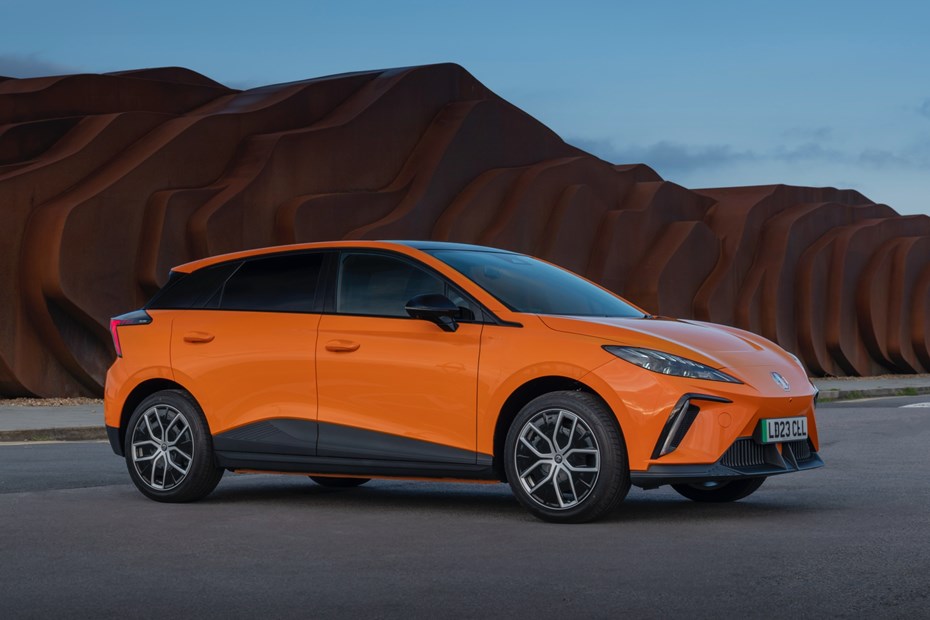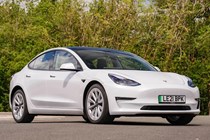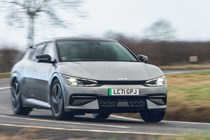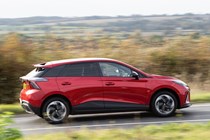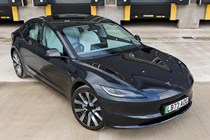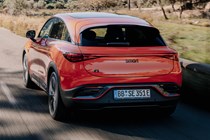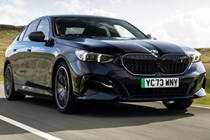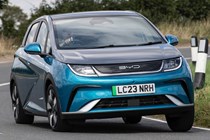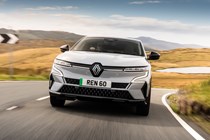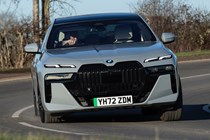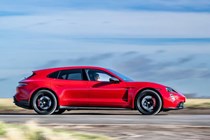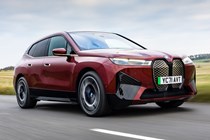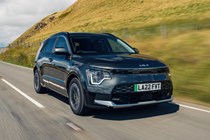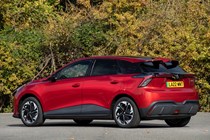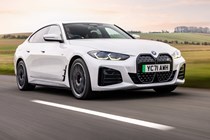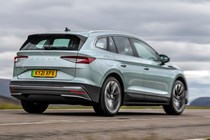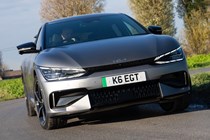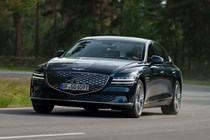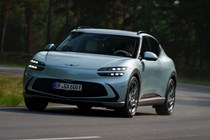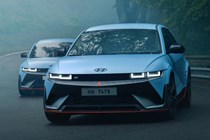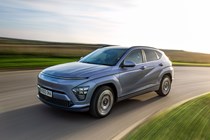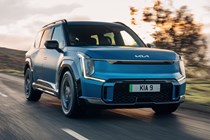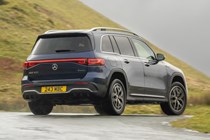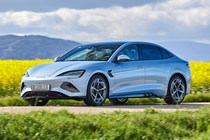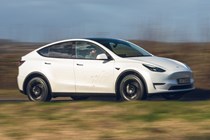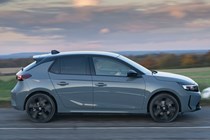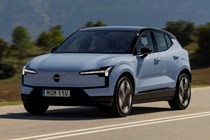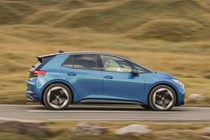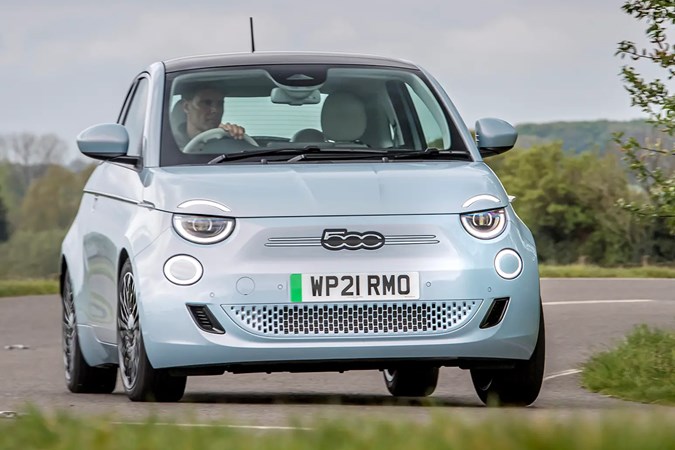Thanks to ever increasing ranges, temptingly priced newcomers and EVs in most categories of car, there’s never been a better time to drive electric. All that choice can be daunting, especially if you’re new to EVs, so we’ve put together this list of the best electric cars in 2024. Split into the different types of electric cars out there, we’ll let you know our editor’s pick and a car worthy of commendation.
EVs have entered mainstream acceptance with the proliferation of public charging stations and increasing pressure on car manufacturers to build cleaner and greener vehicles. Almost every mainstream brand offers at least one family EV now and many new brands are joining the fray. Early EVs were rather expensive and couldn’t go very far but the latest crop offer usefully long range at an affordable price. As good as new electric cars have become, though, the UK charging infrastructure is still of a bit sticking point that puts many people off making the switch.
Still, if you can work around this issue – as many people do – you’ll find that driving and owning an electric car can be a real pleasure. That’s because they’re easy to drive, quiet and quick. So there’s no need to give up the joy of driving when you switch from fossil fuels.
Keep reading to see 24 of the best electric cars on sale in the UK in 2024. They’ve all been extensively tested by Parkers’ experts and offer long range, a great driving experience and good value.
The best electric cars in every category
Small family
Incredible value and good to drive
But there’s more to it than just the low price, the MG4 EV is a genuinely good car. It has a spacious interior, comes well equipped, it’s comfortable and great to drive. Every model has a usefully long WLTP range of well over 200 miles and you get the reassurance of a seven-year warranty. It's so good, we named it our 2024 Car of the Year.
Read our full MG MG4 review
Pros
- Long range
- Good to drive
- Undercuts all rivals on price
Cons
- Touchscreen is fiddly
- Interior feels low rent in places
Keenly priced, spacious and well-equipped
Efficiency and performance impresses and all models get plenty of standard equipment. It also has a surprisingly plush interior, albeit one that looks very Marmite. With prices starting at around £25k for a short range version and some tempting finance deals, it's well worth a look.
Read our full BYD Dolphin review
Pros
- Terrific value and efficiency
- Strong acceleration
- Light and spacious interior
Cons
- Boot not the largest
- Over-eager driver assist systems
Small SUV
A premium experience at mainstream prices
Given the plush if slightly too minimalistic interior, desirable badge and capabilities of the drivetrain, it looks like something of a bargain. After all, and entry-level EX30 costs about the same as a mid-spec
Vauxhall Corsa Electric.
Read our full Volvo EX30 review
Pros
- Great value
- Premium look and feel
- Impressive performance for the money
Cons
- Not the most efficient
- Cramped rear seats and boot
Spacious for its size and very efficient
It's well equipped and reasonably comfortable, but don't expect driving thrills. Acceleration is brisk enough, but the Kona isn't a car that relishes a B road blast.
Read our full Hyundai Kona Electric review
Pros
- 300+ mile range available
- Well equipped
- Spacious for its size
Cons
- Not much fun to drive
- Not the plushest interior
Medium family
The best Renault in ages - premium and comfortable
The ride is better in models with smaller wheels. All models have a 60kWh battery pack, good for a claimed range of up to 280 miles – not the longest you can get in this type of car but more than enough for many motorists’ needs.
Read our Renault Megane E-Tech review
Pros
- Good to drive
- Responsive infotainment
- Spacious, high-quality interior
Cons
- Jittery ride on biggest wheels
- No bigger battery option
Improved EV hatch a great all-rounder
Crucially, it's efficient in the real world giving the big battery versions a genuine real-world range of around 300 miles. With good interior space and a boot that's a decent size too, it's a highly recommendable family EV hatch.
Read our full Volkswagen ID.3 review
Pros
- Good real world range and efficiency
- Practical
- More keenly priced than other European rivals
Cons
- Big battery models expensive
- Fiddly controls are annoying
Medium SUV
Pragmatic and practical, if not very exciting
Performance is perfectly adequate, it drives neatly and is generously equipped. 285 miles of WLTP range is long enough to suit most families’ regular needs and you can trust the predicted range shown in the instrument cluster.
Read our full Kia Niro EV review
Pros
- Seven-year warranty
- Excellent build quality
- Good range and efficiency
Cons
- Some cheap trim inside
- Stiff suspension
Fast and fun to drive
It feels plush inside and comes rammed full of equipment, while space for people is better than you'd think. The boot is small, though.
Read our full Smart #3 review
Pros
- Enjoyable handling
- High-quality interior
- Well-equipped
Cons
- Small boot
- Pricier than more practical #1
Large family
The 5 Series, electrified
If you're thinking that a saloon doesn't make the greatest familiy car, then an estate is on the way. For now, we'd go for a rear-drive i5 40 saloon in M Sport trim. It's so good you don't need the far pricier M60.
Read our full BMW i5 review
Pros
- Great to drive
- Stunning build quality
- Competitive range
Cons
- Feels huge, especially in town
- Annoying driver-assist tech
The best BYD yet
It's busier inside than the Tesla, but we'd argue it's better put together and more spacious. Equipment levels are high and while it's no bargain basement offering, pricing is keen.
Read our full BYD Seal review
Pros
- Excellent range and performance
- Lots of standard equipment
- Spacious
Cons
- A Tesla Model 3 is faster
- A BMW i4 handles better
Large SUV
Our favourite large EV ticks all the boxes
Kia calls the EV6 a crossover, though it’s actually about the same height as the average big estate. That contributes to the car’s great driving experience. All EV6s have a 77.4kWh battery, rear-wheel-drive models have 229hp, all-wheel-drive models have 325hp and the high-performance GT has a whopping 585hp.
Read our full Kia EV6 review
Pros
- Long real-world range
- Strong acceleration
- Good to drive
Cons
- Firm suspension
- Not the largest boot
Former Car of the Year and still one of the best EVs around
Why do we rate it so highly? It’s a consummate family car, for a start. There’s masses of passenger space – enough for a family of five – and a truly vast boot. It’s full of thoughtful little details that make life on the road easier, as well. Add to that a pleasant and comfortable driving experience, useful on-board technology and a range of over 300 miles in 80 models, all at an affordable price. Also available in sleek Coupe form.
Read our full Skoda Enyaq review
Pros
- Good range
- Easy to drive and live with
- Comfortable, practical interior
Cons
- Not the most exciting drive
- Fiddly infotainment
Luxury cars
The best all-electric luxury car on sale
You'll want one of the rear seat packages and possibly the 31-inch cinema screen (yes, really) for the full experience. It won't be cheap, but it feels like it's worth every penny.
Read our full BMW i7 review
Pros
- Outstanding comfort and performance
- Dripping with tech
- Effortless drive
Cons
- Not as nimble as a regular 7 Series
- The techfest takes some acclimatisation
G80 makes a lot more sense as an EV
It's bigger than similarly priced rivals from Mercedes and BMW and certainly feels plusher inside. The badge might not yet carry the same cache, but cars like this will soon change that.
Read our full Genesis Electrified G80 review
Pros
- 323-mile range, 800v charging
- Quick and luxurious
- Impressive ownership package
Cons
- Small boot, tight rear headroom
- Not many dealers
Luxury SUV
Great to drive and lavish inside
Space is generous for four, though the boot is a bit small for a car this size. It’s not exactly light either, but the car’s high-tech carbonfibre-reinforced construction does reduce weight. That contributes to great handling and properly quick acceleration. Some models are capable of going well over 300 miles on a full charge, but their massive batteries do take quite a long time to recharge.
Read our full BMW iX review
Pros
- Stunning interior
- High-tech features
- Fantastic to drive
Cons
- Small boot
- Long charge times at home
The EV6's posh cousin
It's interior won't be to all tastes, but there's no denying the quality of materials used, and it should be reliable, too.
Read our full Genesis GV60 review
Pros
- 300+ miles on a charge
- Premium, tech-filled interior
- Twin motor versions fast
Cons
- Some of the tech is tricky to use
- People will ask you what it is
Company car
One of the easiest electric cars to own, usefully improved for 2024
But the Model 3 is also a really very good car. It’s remarkably spacious for its size, with plenty of room for five adults. There’s loads of features in the infotainment system, the voice-control system is brilliantly easy to use and the car is good to drive. You get at least 344 miles of claimed range, the Long Range model can manage 422 miles. Just a shame that, despite looking like a hatchback, the Model 3 is actually a saloon.
Read our full Tesla Model 3 review
Pros
- Very long real-world range
- Convenient charging network
- Good to drive
Cons
- Some build quality issues
- Not a hatchback
A more practical Model 3
You get the same fantastic charging network, similarly long ranges and strong acceleration. The interior looks great, although you still need to keep an eye out for quality issues.
Read our full Tesla Model Y review
Pros
- Huge boot
- Airy cabin
- Range and performance
Cons
- Stiff ride
- No parcel shelf
Fun car
Proof that electric motoring doesn't have to be boring
It’s pretty practical, too. There’s space for four adults and the boot’s a decent size – much easier to load than that of the Taycan saloon, too. The interior feels properly plush and it’s loaded with technology. Each model is capable of delivering a long range, as well, unless you’re minded to take advantage of the car’s performance as often as possible.
Read our full Porsche Taycan Sport Turismo review
Pros
- Bigger boot than four-door
- Accurate range indicator
- Fantastic to drive
Cons
- Rear legroom a little tight
- Options quickly inflate the price
A supersized EV hot hatch
Our initial impressions abroad did show it to have a stiff ride, but Hyundai will be tuning cars for Europe with a bit more suppleness. If the changes are a success, you might be looking at a new Editor's pick.
Read our full Hyundai Ioniq 5 N review
Pros
- Rapid acceleration
- Fun to drive
- Great interior
Cons
- Stiff ride
- Big and heavy
Seven-seater
Possibly Kia's best car yet
Twin motor versions are quick and still have a decent range and equipment levels are good. It's not cheap, though.
Read our full Kia EV9 review
Pros
- Effortless driving experience
- Superb, high-quality interior
- Super-fast 800v charging
Cons
- Poor air conditioning controls
- Bulky around town
Versatile and compact
It drives well and the range is just about good enough, although we wish there was a cheaper single motor version.
Read our full Mercedes EQB review
Pros
- Drives well
- Tows up to 1800kg
- Looks fancy inside
Cons
- Model Y has a longer range
- No single motor model
First car
The best electric city car is funky, stylish and has real character
We really like the 500 Electric’s quirky, well built interior. There’s plenty of space up front but the back seat and boot are pretty titchy. It’s really good fun to drive, too – effortless to sling around town and there’s enough muscle that motorways hold no fear. Note that the petrol-powered 500 and 500 Electric are completely unrelated.
Read our full Fiat 500 Electric review
Pros
- Fun to drive
- Good value for money
- Decent range for its size
Cons
- Tiny rear seats
- Cheap entry-level model no longer available
An easy transition to electric cars
There are some cracking finance deals out there, and with five doors it's reasonably practical, too.
Read our full Vauxhall Corsa Electric review
Pros
- 54kWh battery improves range significantly
- Fun to drive
- Easy to use infotainment
Cons
- Limited boot space
- Top models pricey
What is an electric car (EV)?
An electric vehicle, also known as an EV, or sometimes BEV (battery electric vehicle), uses at least one electric motor as its only source of propulsion. That motor is powered by electricity contained in a battery pack mounted somewhere in the car, usually below the boot or the floor of the interior.
The battery pack needs recharging periodically, as indicated by the gauge or read-out in the car’s instrument display. You can use a regular three-pin socket to recharge but that can take a very long time. It’s better to use a dedicated charge point. You can have one installed at home (usually referred to as a wallbox), though the wiring may need upgrading to cope.
An increasing number of public and workplace charging stations are being rolled out across the country, as well. The network is continually growing, though coverage is still spotty in certain areas. Be aware that the various charging station operators have different payment methods, many of which require opening an app-based account.
Electric Vehicles Frequently Asked Questions (FAQs)
How much money do you save now with your EV?
The cash and PCP prices you’ll pay for a new electric vehicle are generally higher than you’d pay for an equivalent petrol or diesel car. For instance, an entry-level Volkswagen ID.3 costs about £9000 more than an entry-level Golf.
That is starting to change, however, as more and more bargain-priced EVs enter the market. The MG 4 is a prime example. Its starting price undercuts plenty of other midsize hatchbacks with ICE power.
Do EVs drive differently to conventional vehicles?
An EV is no different to a petrol or diesel car with an automatic gearbox in how you drive it. You just get in, press the start button, put the gear selector in Drive, then press the pedals and turn the steering wheel. There are two big differences you’ll notice, though.
First, and most obviously, is that an EV is very quiet – there’s no engine, after all. You will notice plenty of other noises the car makes, but the vast majority of EVs are positively serene to travel in. Be aware that the quietness can cause car sickness in some people – it turns out sound is pretty crucial to our sense of motion.
The second thing you’ll notice is that the brakes feel a bit odd. That’s because of the regenerative braking, a clever system that harvests energy that would otherwise be wasted when you brake or just lift off the accelerator and feeds it back into the battery. The system amplifies the braking force, which can take a bit of getting used to. Once you’re accustomed to it, though, you might find you rarely need to use the brakes. Some EVs even have a ‘one-pedal’ driving mode.
Can electric car batteries be recycled?
Yes. All new EVs sold since the 1990s have been powered by lithium-ion (Li-On) batteries, which are relatively easily recycled. The days when the lead acid batteries that powered ancient EVs like milk floats were just chucked into landfill have long gone. Li-On batteries are also found in phones and laptops and a thriving recycling industry has grown up around them.
EV batteries are being recycled in a number of different ways. For instance, some EV manufacturers, including Tesla, are taking batteries that have reached the end of their working life in a car to recycle and repackage them into storage batteries that can be hooked up to renewable energy sources like wind and solar and used to power buildings and infrastructure.
How far can a typical EV travel on a single charge?
EV range has improved dramatically in recent years – the days when you’d struggle to go more than 100 miles are far behind us. Indeed, every EV currently on sale in the UK has a range well into three figures, as measured on the WLTP cycle. Most can go somewhere between 200 and 300 miles between recharges, some can do a lot more than that, like the Mercedes EQS.
Driving in the real world, the range you get from an EV is affected by many factors. Things like cold weather, using lots of the car’s electrical features – particularly the aircon – what type of road you’re on and your own driving style can vary the car’s range from the advertised figure.
How do I know an electric car is right for me?
It depends on how you use your car and where you live. Let’s look at a few scenarios. If you rarely journey more than 100 miles from home and have a driveway, then an electric car could suit you pretty much perfectly. Just make sure you plan those occasional long-distance trips around charging stops. Don’t have access to off-street parking? That makes charging while you’re at home tricker, but there are solutions available. Many places now have roadside chargers in residential areas, you can even get portable EV chargers.
If you regularly go on long-distance trips, driving an EV is trickier. They tend to chew through their charge pretty quickly on motorways so you find yourself at the mercy of the UK’s less-than-perfect charging network more often. You may not have the time it takes to charge to spare, either. But the proliferation of long-range EVs means there are now options that work perfectly well for doing big mileages.
How about if you need a big, chunky SUV that can tow a huge caravan around the country? Well, there are some that can pull the weight, but they need recharging so often that they become impractical for the job.
How do I charge my EV?
There are several ways of getting juice into your EV. If you’re at home, you can use a regular three-pin wall socket, at least if you’re not going anywhere for a day or so because it usually takes ages. Alternatively, you can get a home chargepoint (also known as a wallbox) installed. You ideally need off-street parking, your home’s electrics may need upgrading to suit and you’ll need to make sure you get a charger that’s recommended for your car. Change car and you may need a new box. Some manufacturers include a wallbox with the purchase of their EVs.
When you’re out and about, you’ll find charge points in all sorts of locations, most often in car parks. There are some well-documented issues with the UK’s charging network and you need to carefully plan longer journeys around charging stop. If everything comes together, recharging an EV can be almost hassle-free. And as the charging infrastructure grows, it will only get easier.
What happens if I run out of power?
The best advice is not to let an EV run out of charge if it can at all be helped. If it does happen, the car essentially locks up, becoming a brick that can be very difficult to move. When the charge in the car’s battery drops below a certain level, the motor’s power will be cut back and non-essential electrical features will turn off.
You’ll be going some to reach that point, though, given the number of warnings that pop up in the instrument display. If you know that you’ll reach a charging station before the situation becomes critical, there’s no reason to worry. If not, the car’s satnav should be able to point you in the right direction, or you can use a charger locator app like Zap Map.
Do EVs cost more than petrol and diesel cars?
Generally speaking yes, they do, and often by quite a large margin, regardless of whether you buy outright or use financing via PCP or lease. However, the price gap is starting to come down and there are a number of brands bringing new EVs to market targeting buyers on a lower budget.
What are resale values like for EVs?
The residual values for electric vehicles haven’t been great for many years, due to a lack of demand and concerns about the long-term durability of EVs. However, the long-running issues many manufacturers are having in delivering new EVs means demand for used ones is increasing which means prices for them are steadily rising.
Are EVs really better for the environment?
This is a very thorny issue. There are strong opinions on both sides of the question, but the simple fact of the matter is that electric cars haven’t been around long enough in sufficient numbers for us to really know the long-term environmental impact they will have, for good or bad.
But here are a few irrefutable facts. Because they don’t produce any exhaust emissions, they do help to improve air quality where they are used, particularly in towns. They help reduce CO2 emissions, as well. There is the question of how the electricity that powers an EV is generated but, in the UK at least, zero-CO2 renewable energy makes up an ever-bigger proportion of electricity generation.
How much CO2 is generated over the course of an EV’s entire lifecycle is harder to pin down. The most comprehensive study so far was carried out by EV manufacturer Polestar. It found that building an EV produces vastly more CO2 than building a petrol or diesel car and that deficit takes around 70,000 miles of driving to pay back. However, over the rest of an EVs life, its CO2 footprint is much, much smaller than the petrol or diesel car’s.
That’s just one study, though, and more work needs to be done to come up with a definitive verdict. Other potential issues with electric cars are also being investigated – the increased particulate emissions they generate from tyres and brakes, for instance.
Overall, though, it has to be concluded that using electricity to power cars is better for the environment than petrol or diesel.
Alan Taylor-Jones is the New Cars Editor for the Bauer Digital Automotive Hub, working on both Parkers and sister title CAR. When not driving the latest cars you can find him busy with a young son or playing with RC cars.



